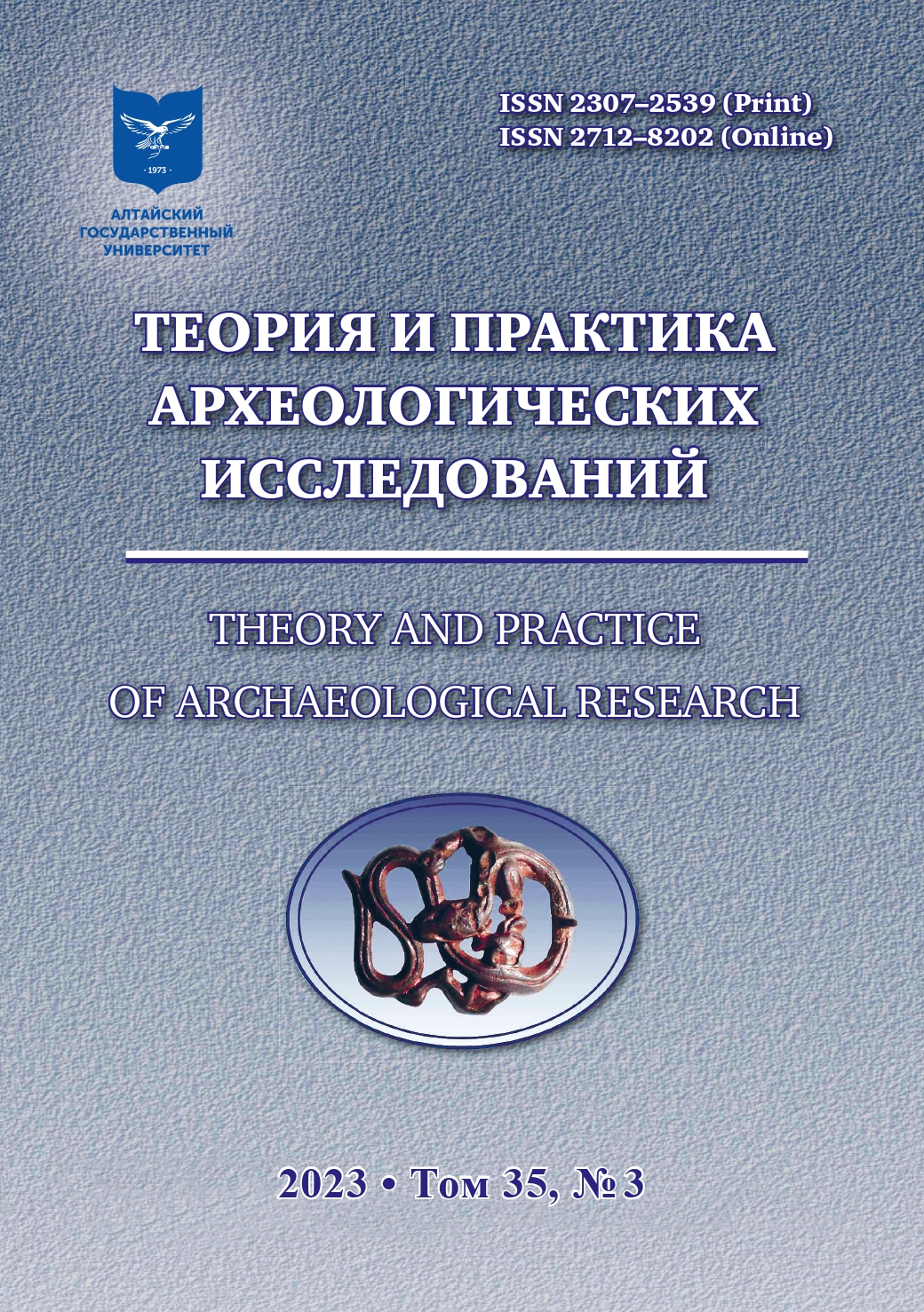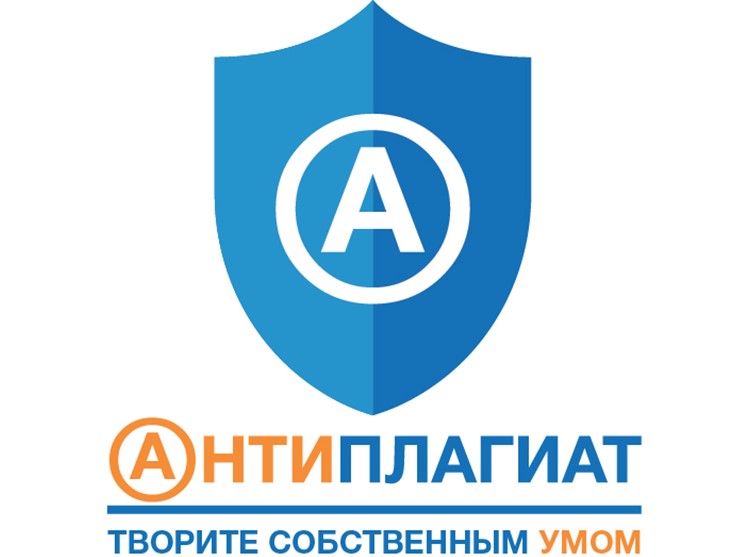TETIUSHI-II HILLFORT — AN URBAN-TYPE SETTLEMENTOF THE EARLY MIDDLE AGES
Abstract
The article deals with the issues related to the problem of the existence of urban-type settlements in the Early Middle Ages in the Volga-Kama. On the example of the materials of TetiushiII hillfort located on the right bank of the Volga, the author gives arguments confirming this thesis. Having been studied for six seasons since 2007, Tetiushi-II hillfort has a unique stratigraphy which made it possible to identify the chronological stages of its existence, as well as to determine the peak of its functioning — the second half of the 6th — first half of the 7th centuries. The hillfort, as well as the settlement adjacent to it from the side facing the enemy, belongs to the Imen’kovo culture. A clear layout of the hillfort was recorded: an industrial site with furnaces and melting pits in the northern part of this settlement, an area of craft workshops and residential estates in the southern part of the site near the rampart. The population of the hillfort was engaged in crafts, trade, and had a developed system of cults and was multi-ethnic.
Downloads
Metrics
References
Bondarenko D.M., Grinin L.E., Korotaev A.V. Alternatives of Social Evolution. In: Early State, its Alternatives and Analogues. Volgograd : Uchitel, 2006. Pp. 15–36. (In Russ.)
Bugrov D.G. Burial of a “Craftswoman” Woman from the Tetiushi II Burial Ground. In: Materials of Local History Readings Dedicated to the 135th Anniversary of the Society of Naturalists at KSU, the 110th Anniversary of the Birth of M.G. Khudyakov. Kazan : Shkola, 2004. Pp. 77–94. (In Russ.)
Valiev R.R. Novoslavski II Burial Ground: Problems of Interpretation and Research Perspectives. In: Nomadic Empires of Eurasia in the Light of Archaeological and Interdisciplinary Research. Book 1. Ulan-Ude : BNC SO RAN, 2019. Pp. 109–116. (In Russ.)
Vyazov L.A., Semykin Yu.A. Hillfort and Settlement Novaya Bedenga: the Era of the Great Migration of Peoples in the Ulyanovsk Pre-Volga Region. Ulyanovsk : NII istorii i kul’tury, 2016. 227 p. (Archaeology of the Simbirsk Volga region. Issue 1). (In Russ.)
Kazakov E.P. Tetyushi Burial Ground of the Azelin Culture. In: Materials and Research on Medieval Archaeology of Eastern Europe. Kazan : Shkola, 2009. Pp. 31–44. (In Russ.)
Kazakov E.P. Volga-Kama Area in the Era of the Turkic Khaganates. Book one: Comintern II Burial Ground. Kazan : AN RT, 2020. 148 p. (Archaeology of the Eurasian Steppes. Issue 26). (In Russ.)
Kalinin N.F., Khalikov A.Kh. Imenkovo hillfort. In: Proceedings of the Kuibyshev Archaeological Expedition. Vol. III. Moscow : AN SSSR, 1960. Pp. 225–250 (Materials and Research on Archaeology of the USSR. No. 80). (In Russ.)
Kradin N.N. The Origin of Inequality, Civilization and the State. St. Petersburg : Izdatel’stvo Olega Abyshko, 2021. 336 p. (In Russ.)
Matveeva G.I. Middle Volga Region in the 4th–7th Centuries: Imenkovo Culture. Tutorial. Samara : Izdatel’stvo universiteta, 2003. 160 p. (In Russ.)
Ostanina T.I. Kirbi Hillfort on the River Mesha. Finno-Ugrica. 2002;1(5–6):15–43. (In Russ.)
Ostanina T.I., Kanunnikova O.M., Stepanov V.P., Nikitin A.B. Kuzebaevo Treasure of a Jeweler of the 7th Century as a Historical Source. Izhevsk : Udmurtiya, 2011. 218 p. (In Russ.)
Patrushev V.S. Burial Grounds of the Volga-Kama Region of the Early Ananyino Time. Kazan : Foliant, 2011. 276 p. (Archaeology of the Volga and Urals. Materials and Research. Issue 2). (In Russ.)
Rudenko K.A. Tetiushi II Hillfort in Tatarstan. Kazan : Zaman, 2010. 152 p. (In Russ.)
Rudenko K.A. Ancient Tetiushi. Archaeological Research. Kazan : Zaman, 2011. 144 p. (In Russ.)
Rudenko K.A. On the Nature of the Relationship between the Nomadic Ugric Peoples and the Settled Population of the Middle Volga Region in the “Epoch of the Great Migration of Peoples” (based on materials from the Tetiushi II hillfort in Tatarstan). Teoriya i praktika arheologicheskih issledovanij = Theory and Practice of Archaeological Research. 2013;2(8):58–74. (In Russ.)
Rudenko K.A. The Hoard of Iron Axes from the Tetiushi II Hillfort in Tatarstan of the Early Middle Ages. Teoriya i praktika arheologicheskih issledovanij = Theory and Practice of Archaeological Research. 2014;1(9):42–60. (In Russ.)
Rudenko K.A. Stratigraphy of the Settlements of the Imenkovo Culture of the Kazan Volga Region. Teoriya i praktika arheologicheskih issledovanij = Theory and Practice of Archaeological Research. 2018;2(22):80–98. (In Russ.)
Rudenko K.A. Metallurgical Production of the 6th –7th Centuries. AD on the Tetyushi II Hillfort in Tatarstan. Teoriya i praktika arheologicheskih issledovanij = Theory and Practice of Archaeological Research. 2019;1(25):16–28. (In Russ.) DOI: 10.14258/tpai(2019)1(25).-02.
Rudenko K.A. Crucibles of the 6th –7th Centuries. AD Imenkovo Culture. Teoriya i praktika arheologicheskih issledovanij = Theory and Practice of Archaeological Research. 2020;3(31):65–81. (In Russ.) DOI: 10.14258/tpai(2020)3(31).-06.
Rudenko K.A. Markers of Metallurgical and Jewelry Production in the Settlements of the 6th–7th Centuries. AD Middle Volga region (on the example of the Tetyushi II settlement in Tatarstan). Teoriya i praktika arheologicheskih issledovanij = Theory and Practice of Archaeological Research. 2020a;2(30):24–34. (In Russ.) DOI: 10.14258/tpai(2020)2(30).-02.
Rudenko K.A. Miniature Clay Items of the Imenkovo Culture of the 6th–7th Centuries. AD. Teoriya i praktika arheologicheskih issledovanij = Theory and Practice of Archaeological Research. 2021;4(33):81–106. (In Russ.) DOI: 10.14258/tpai(2021)33(4).-05.
Rudenko K.A. On the Issue of Synchronization of the Imenkovo Settlements and Burial Grounds of the Kazan Volga Region. Ezhegodnik finno-ugorskih issledovanij = Yearbook of Finno-Ugric Studies. 2022;3(16):470–479. (In Russ.) DOI: 10.35634/2224-9443-2022-16-3-470-479.
Ruslanov E.V., Shamsutdinov M.R., Romanov A.A. Early Medieval Antiquities of the Ufa Peninsula. Hillfort Ufa-II. Materials of Archaeological Excavations in 2015. Ufa : GBU Respublikanskij istoriko-kul’turnyj muzej-zapovednik «Drevnyaya Ufa», 2016. 266 p. (In Russ.)
Starostin P.N. Settlements of the Imenkovo Culture. Moscow : Nauka, 1967. 100 p. (SAI. Issue D1-32). (In Russ.)
Starostin P.N. Maklasheevo II Ancient Settlement of the Imenkovo Culture. In: Proceedings of the Kama Archaeological Expedition. Issue IV. Perm : PGU, 1968. Pp. 221–229 (Scientific notes of PGU; No. 191). (In Russ.)
Starostin P.N. Works on the Troicko-Urajsk I Hillfort in 1973 // Antiquities of the Volga-Kama Region. Kazan : IYaLI KFAN, 1977. P. 31–41. (In Russ.)
Starostin P.N. Early Medieval Settlement “Kurgan”. In: Medieval Archaeological Settlements of Tataria. Kazan : IYaLI KFAN, 1983. Pp. 6–19. (In Russ.)
Stepanov P.D. Osh Pando. Saransk : Mordovskoe knizhnoe izdatel’stvo, 1967. 212 p. (In Russ.)
Stolyarova E.K. Glass Beads of the Tetiushi II Hillfort. In: Materials and Research on Medieval Archeology of Eastern Europe. Kazan : Shkola, 2009. Pp. 66–75. (In Russ.)
Khalikov A.Kh. Volga-Kamie at the Beginning of the Early Iron Age (the 8th –6th Centuries BC). Moscow : Nauka, 1977. 262 p. (In Russ.)
Stolyarova E. Glass Beads of the Imenkovo Culture (on the materials from the Tetiushi II settlement, Middle Volga). 22nd Annual Meeting of the EAA. 31st August — 4th September 2016 Vilnius. Abstracts. Vilnius, 2016. P. 220.
Copyright (c) 2023 К.А. Руденко

This work is licensed under a Creative Commons Attribution 4.0 International License.
Theory and Practice of Archaeological Research is a golden publisher, as we allow self-archiving, but most importantly we are fully transparent about your rights.
Authors may present and discuss their findings ahead of publication: at biological or scientific conferences, on preprint servers, in public databases, and in blogs, wikis, tweets, and other informal communication channels.
Theory and Practice of Archaeological Research allows authors to deposit manuscripts (currently under review or those for intended submission to ABS) in non-commercial, pre-print servers such as ArXiv.
Authors who publish with this journal agree to the following terms:
- Authors retain copyright and grant the journal right of first publication with the work simultaneously licensed under a Creative Commons Attribution License (CC BY 4.0) that allows others to share the work with an acknowledgement of the work's authorship and initial publication in this journal.
- Authors are able to enter into separate, additional contractual arrangements for the non-exclusive distribution of the journal's published version of the work (e.g., post it to an institutional repository or publish it in a book), with an acknowledgement of its initial publication in this journal.
- Authors are permitted and encouraged to post their work online (e.g., in institutional repositories or on their website) prior to and during the submission process, as it can lead to productive exchanges, as well as earlier and greater citation of published work (See The Effect of Open Access).








2.jpg)




